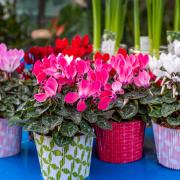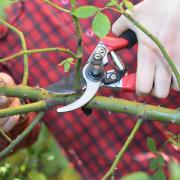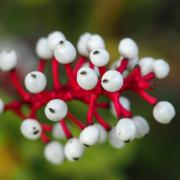As summer continues with little rain and a hosepipe ban in some areas, it’s time to get waterwise with your garden. But how?
Emma O’Neill, head gardener at Garden Organic, designed the charity’s Backyard Biodiversity Garden at this year’s Gardeners’ World Live show, which featured simple water-saving solutions. She suggests the following measures…

Use olla pots
These are clay irrigations pots that can be buried into beds and filled with water, allowing moisture to seep gently into the soil to direct water to the roots.
“They look like an urn or a large specimen bottle with a long tube at the top and a bulbous bit at the bottom. They are made out of terracotta so they are porous and you bury them up to the neck and fill them with water, and the water seeps out slowly, watering the plants,” says O’Neill.
You could mix some liquid feed into the water in the olla pot, so thirsty plants will also be fed.

Try rain chains
These decorative links – often seen hanging below a roof gutter – collect rain water and channel it to where it’s needed, diverting water to maybe a watering can or pot underneath.
“They won’t provide loads of water but if you haven’t room for a water butt, you can put them on the guttering to collect the water. We put our watering cans underneath them to save the rainwater,” says O’Neill.
Make the most of water butts
“With climate change, we are getting much wetter winters,” says O’Neill. “You should be able to store the water over the winter in preparation for warmer weather.
“Some people find them ugly or don’t have enough room, so we would recommend is that you can just use a trug or a bucket. Any little bit of water is better than having to use your tap. Rainwater is beneficial because it doesn’t have all the minerals and chemicals tap water has.”

Use grey water
Even if it’s too tricky to save your bath water – unless you can scoop it out into a bucket or washing up bowl – you may be able to use your washing-up water provided it has eco-friendly detergent, but don’t use it all the time because over time it may change the composition of the soil, O’Neill advises.
Water in the morning
Water early in the morning to give plants the water they need through the day, the RHS advises. And don’t water your lawn, which will recover during the autumn rainfall.
Train plants to need less water
The RHS says you can encourage plants to drink less if you give them less water, encouraging them to drink more slowly. With pot plants, you could place a saucer under the pot to save the water which drains through, as some of the water will be drawn back towards the roots, although you shouldn’t leave pots standing in water for long.

Explore Xeriscaping
Trending in the US, xeriscaping is basically landscaping with slow-growing, drought-tolerant plants, using mulch to cover the ground and reduce the need for watering. It might involve replacing moisture-loving lawns with ornamental grasses, or other drought-tolerant plants such as sedum, rock roses and verbena.
Plant them in free-draining soil and improve drainage, perhaps by building raised beds with retaining walls around them and adding grit to the topsoil for alpines and Mediterranean plants, so that they don’t become waterlogged in the autumn and winter. Gravel gardens are another xeriscaping option for small gardens, if you add a little compost topped with a few inches of gravel.
Water plants which need it most
Mediterranean plants like bedding geraniums, drought-tolerant grasses and woody plants such as lavender and rosemary don’t need a lot of water, but large-leaved plants such as bananas need much more. Water at the base of the plant to allow the roots to get the moisture they need.
Mulch around plants
Use a bark or gravel mulch or bulky organic matter on the soil surface to retain moisture and help minimise evaporation, O’Neill advises.
Water generously less frequently
If you water little and often, it will just encourages surface roots, whereas watering more thoroughly less often helps to get the down to the deeper roots, the RHS advises.

Consider an automatic irrigation system
Ceri Thomas, editor of Which? Gardening, says: “Whether you’re at home or on holiday, setting up an automatic irrigation system can be a great way of making sure your plants are regularly watered – saving you a lot of time and effort in the process. If you’re in the market for an irrigation system, carefully consider what’s most important for you. Most kits need to be connected to a tap. If you want to connect your kit to a water butt or tank then you’ll need to buy a solar-powered kit,” Thomas adds.
“A lot of kits are modular – so you can add to them – but it’s also worth checking how much pipe is included in the kit so you know whether it will reach from your tap to the most distant pot. If you rearrange your pots from year-to-year then it’s worth looking for a kit that allows you to plug holes or add new pipes.”
O’Neill adds: “The leaky hose system is probably better because the spikes tend to water a lot of the foliage, which can then cause scorch and doesn’t get down to the roots of the plants.”
Stick to drought-tolerant plants
Plants with grey or silver leaves including lavender, stachys and santolina tend to withstand long periods of hot weather, O’Neill says. Sedums and other plants with waxy, succulent leaves are also drought-tolerant.


























